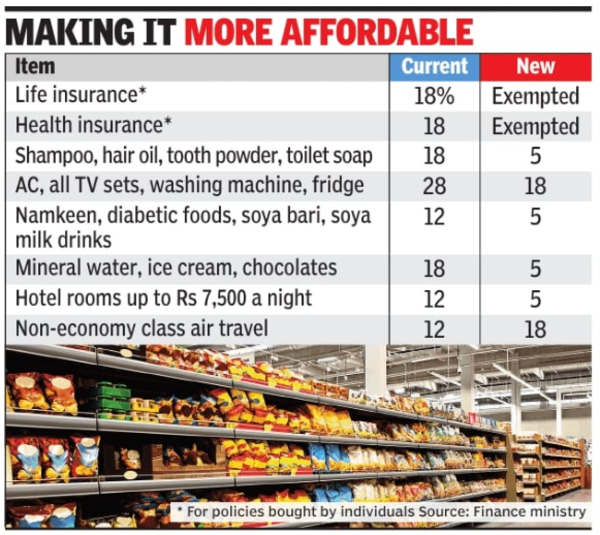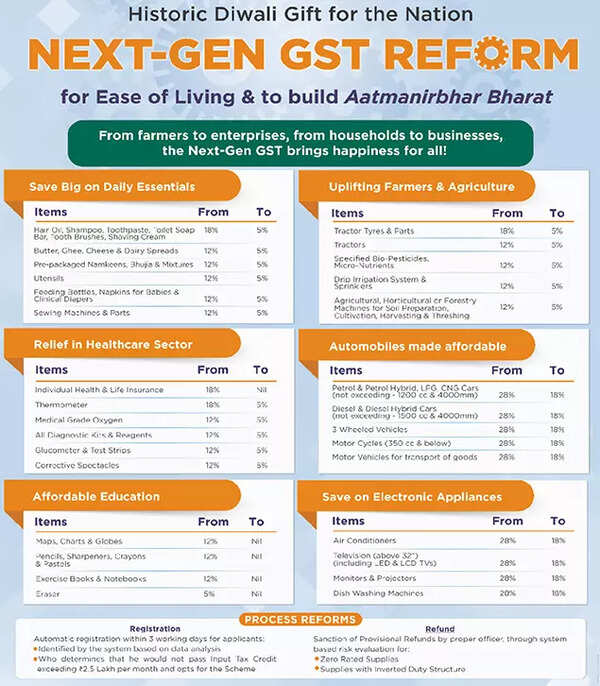India’s sweeping Goods and Services Tax (GST) overhaul—spanning nearly 400 goods and services—takes effect on September 22, 2025, with businesses rushing to ensure savings reach the market. Yet, getting the benefits from tax revisions into consumers’ wallets involves a complex, behind-the-scenes journey.
Logistical Challenges: Old Inventory, New Rates
GST is embedded in products from the moment they’re invoiced. Consequently, items already dispatched or invoiced before the rate change carry old tax values. To accommodate the new, lower rates, manufacturers must connect a web of coordination among manufacturers, distributors, and retailers, ensuring prices reflect the new tax structure.
Sector-by-Sector Pass-Through Strategies
FMCG (Fast-Moving Consumer Goods)
Small fixed-price packs (like Rs 5 or Rs 10 snacks) are expected to maintain their price by increasing the quantity rather than cutting rates—preserving affordability while reflecting the tax benefit. For other products like soaps and toothpaste, fresh stickers and updated packaging will reflect the new lower rates.

White Goods (TVs, ACs, Refrigerators)
With GST reduced from 28% to 18%, consumers are expected to benefit from lower prices. Manufacturers have assured dealers they will absorb the tax loss on older inventory to prevent a price spike.
Hospitality & Air Travel
Hotel rooms under Rs 7,500 will attract only 5% GST—down from 12%—but only if paid at check-in. Prepaid bookings won’t benefit, as the service is deemed rendered when paid for, not when consumed. In contrast, GST on premium airfares has risen from 12% to 18%, with purchases made after Sept 22 subject to the new rates.
Insurance
Life and health insurance policies are now GST-exempt, translating to an 18% notional savings. However, insurers are grappling with the removal of input tax credits on operational costs and may offer value-adds (like expanded coverage) rather than premium cuts.
Automobiles & Dealers
This sector faces the biggest turbulence. With GST and cess restructured, dealers burdened by existing stock purchased under old rates face losses. While tax on some models drops to 40%, dealers can’t reclaim the previous cess, leading to out-of-pocket losses. Some manufacturers are offering partial support, but many are still vulnerable.
Systemic Adjustments Needed Behind the Scenes
Implementation isn’t as simple as flipping a switch. ERP software, billing systems, and point-of-sale terminals need updates to reflect new GST bands. Large retailers may adapt quickly, but smaller kirana stores could struggle with timely implementation. Additionally, credit note mechanisms between supply chain layers must function smoothly to adjust prices in real time.
What the Government Is Doing
Acknowledging the complexities, policymakers are proactively monitoring the rollout:
Both central and state authorities, along with the CBIC, will engage with businesses to ensure compliance and that price drops materialize.
Finance Minister Nirmala Sitharaman highlighted the urgency of supervision, especially as reforms align with the festive spending season. She affirmed vigorous oversight to prevent price manipulation and ensure “benefits reach the common man.”

Key Takeaways at a Glance
Sector Strategy for Passing on Benefit Key Concern
FMCG Gram adjustments for fixed-price packs Ensuring pack size changes, not prices
White Goods Manufacturers absorb losses Balancing old-stock pricing vs. new rates
Hotels & Travel 5% GST for check-in bookings Uniform application at point of service
Insurance GST waiver and potential service enhancements Impact of losing input tax credits
Auto Dealers Partial manufacturer support Losses on pre-stocked inventory
Bottom Line
From recalibrating billing systems to managing dealer expectations and coordinating across the supply chain—transmitting GST cuts to consumers is no small logistical feat. Yet, with strong government oversight and active industry participation, these reforms aim to deliver real affordability and consumption boosts just in time for the festive season.



